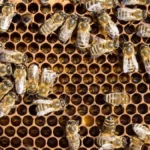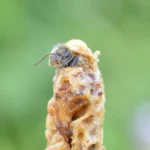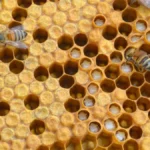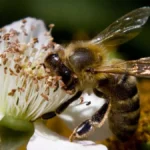What are baby bees called? Brood. Now that we have that cleared up, let us have a closer peek at what brood actually is! The baby bee life cycle, or brood rearing cycle is an amazing process that produces thousands of workers a day in a big hive. Let us explore what baby bees are called and see how the beehive produces this tidal wave of baby bees each day.
What Are Baby Bees Called?
A bee starts its life as an egg laid by the queen (most of the time, but we will not go into that here). If the queen’s legs are wide open when she lays the egg, she knows she is in a big drone cell and lays an unfertilized egg – this egg will develop into a big (and very stupid) male bee or drone. If the queen’s legs are close together she knows she is in a small worker cell, and she will lay a fertilized egg. This will develop into a worker, or under emergency circumstances, a queen.
The egg hatches and is fed royal jelly and then pollen – this is the larval stage. The bee larvae look like little worms. They swim in their food and eat it. Once the larvae are big enough, they will orientate head first in the cell, and the cell gets capped. The larvae form a silk cocoon and metamorphosis occurs resulting in adult bees emerging.

Read more about: Drone Brood vs Worker Brood
So let us summarize what happens – worker bees go out to flowers and collect pollen and nectar. This acts as food and fuel to drive the energy and nutrient balance in the hive so that workers can rear the queens’ eggs out into new workers, drones, and queens to keep the hive going. In this way, a beehive filters hundreds of pounds a year of nectar and pollen to produce bees that run the hive. This is amazing on every level possible.
What Are Immature Bees Called?
What are baby bees called – Brood! Ok, we went into that above – now to the next stage. When an immature young bee hatches it is a pretty sorry and confused little thing. They have a grey pathetic look and just walk slowly around in the chaos of the hive. Imagine having spent your whole life in a nice cozy place and now suddenly you are out in the real world and this world involves 60 000 busy ladies buzzing around inside a box doing stuff. It is a shock.
Within a few hours, the nurse bees lick the emerged baby bee and she hardens up – her appearance takes on a more fluffy look and she gets a more decisive walk. At this stage, she will be steered by her sisters to various early hive activities. Depending on what the hive needs to be done, more often than not a young bee will become a nurse bee, or will be taken to a festoon for wax making. Young bees have particularly good wax-making skills.
Division Of Honey Bee Labor
Bees have a progressive division of labor – bees start their lives and migrate through the hive doing various jobs as they get older. It is a bit like the amazing Japanese Kaizen system of organization improvement where every worker has an understanding of every other worker’s job and aims for the incremental improvement of the organization/hive.
A young bee emerges and often works cleaning cells, later being a nurse, migrating to wax production and pollen and nectar processing, hive ventilation, defense, foraging, etc. There are a lot of tasks and bees move through these tasks in an age-related progression.
It is important to note that in an emergency, bees that have migrated up the chain of work can move back to any step. In other words, a worker who has become a forager and is working in the fields collecting nectar can move back to the hive duties and become a wax maker, or a nurse bee – this is undesirable – but in an emergency, she can make this change.
Young Bee In Human Culture
In many human cultures, the so-called “young bee” is an important nutrient and medicine. Young bees or bee brood is a nutritious food. If bee brood is fresh and in new combs, you can actually take a comb and fry it in a pan. The wax becomes liquid frying the larvae. This makes a delicious crispy snack much like small shrimp.
In parts of China, drone brood is known as “Chinese viagra”. You can imagine that consuming lots of larvae that are essentially flying testicles will most likely provide a man with all the nutrients he needs for his own reproductive functioning. In many cases, age-related declines in reproductive efficacy are due to nutrient deficiencies. Consuming a rich source of “male nutrients” repairs this problem without tinting the world light purple as occurs with medications such as Viagra.

You will notice in this 500-year-old San painting the artists were acutely aware of the beneficial effects of men eating hive products as is evident in the honey hunters substantial “third leg” which is proudly on display. This is also why in European cultures mead was drunk for a month after marriage “to ensure conception” or honeymoon. Old European mead was Whole Hive mead and included the brood.
Feeding Honey Bee Brood To Chickens
There are times when we can remove drone brood from hives to control varroa, or a hive dies, or we do a bee removal and have brood. Feeding this to chickens produced the most amazing eggs! After chickens have eaten eggs they produce the biggest fattest chicken eggs you can imagine. The brood improves the taste of the eggs, and you will feel very healthy after eating such eggs.
A Simple Bee Brood Recipe
Take two combs of near capped brood – ie the larvae have not formed caps yet, but are pretty big and fill up most of the cell. It is better if you can find drone brood. Make sure that the combs are in fresh wax – if brood has been in wax for a few cycles the wax builds up a layer of bee silk which just tastes bad and is chewy.
Fresh combs melt and the brood fries in the wax. Mix in a bit of garlic and a dash of balsamic (or honey vinegar) towards the end. If you wish, a bit of Peri-Peri spice adds a nice zang to it.
The brood can be served on toast or rice cakes and a bit of mashed avocado goes well with this. It takes a bit of getting used to, but after you eat it three times you will start to like it. The eating of brood seems to have a very beneficial effect on ladies’ skin, reducing period-associated pimples, and for men – well remember that San painting above. We need not elaborate.
What are baby bees called? Brood, Chinese viagra – or lunch! Depends. Whatever you call brood, it is an amazing process that bees use to convert pollen and nectar into efficient bees that make our world a beautiful place. If you enjoyed this please share. And if you fry brood….just make sure you plan the next few days of your life carefully. Ideally not a singles food. Share the article if you enjoyed it!!
Learn more about: How To Raise Honey Bee Queens
Baby Bee FAQs
What are baby bees called?
Baby bees are collectively called “brood.” This term refers to all immature bees, including eggs, larvae, and pupae before they emerge as adults.
How does the brood cycle work?
The brood cycle begins with the queen laying eggs, which hatch into larvae. The larvae are fed by worker bees, then pupate, and finally emerge as adult bees.
How long does it take for a baby bee to become an adult?
The time for a bee to develop from an egg to an adult varies by type: worker bees take about 21 days, drones 24 days, and queens 16 days.
What do larvae eat during development?
Bee larvae are initially fed royal jelly by nurse bees, then a mixture of pollen and honey as they grow.
How does the queen decide to lay male or female eggs?
The queen determines the sex of the egg based on the size of the cell. Larger cells receive unfertilized eggs (which develop into male drones), while smaller cells receive fertilized eggs (which become female workers or queens).
What happens to the brood during winter?
In cold climates, brood rearing usually slows down or stops in winter as the colony conserves resources, focusing on survival rather than reproduction.
What role do nurse bees play in the brood cycle?
Nurse bees, usually younger workers, tend to the brood by feeding larvae, maintaining brood temperature, and capping cells once larvae are ready to pupate.
Can worker bees become queens?
Yes, in emergencies, worker bees can raise a new queen by feeding selected larvae exclusively with royal jelly, which triggers their development into queens.
Why do beekeepers sometimes remove drone brood?
Beekeepers may remove drone brood as part of varroa mite control, as mites prefer to infest the larger drone larvae.
Is bee brood used as food for humans or animals?
In many cultures, bee brood is considered a delicacy or a protein-rich food source. It can also be fed to chickens, leading to larger and more nutritious eggs.

Dr. Garth A. Cambray is a Canadian/South African entrepreneur and beekeeper with 28 years of experience in apiculture and specializes in adding value to honey. His Ph.D. research developed a new advanced continuous fermentation method for making mead that has resulted in a number of companies globally being able to access markets for mead. His company, Makana Meadery, exports honey mead to the USA where it is available to discerning connoisseurs. He has also developed technologies to commercially manufacture organic honey vinegar in Zambia for export globally. He holds a few patents globally in the ethanol industry and believes in technology and knowledge transfer for human development and environmental sustainability. One of his proudest achievements is the fact that the wind farm he started at one of his old apiary sites has essentially made his hometown carbon neutral.






